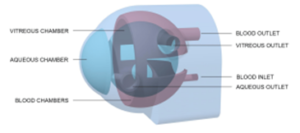WATERLOO, Ontario, August 22, 2022—An ingenious development from the Centre for Ocular Research & Education (CORE) has unlocked a path to faster, inexpensive eye model creation for use in ophthalmic drug research. Using a commercially available masked stereolithography printer (mSLA) retrofitted with humidity and temperature controls, plus a new gelatin-based ink formulation, a team of scientists 3D bio-printed an in vitro eye model in under three hours.
 The resulting “eye” included aqueous, vitreous, and blood chambers, a blood outlet/inlet, aqueous and vitreous outlets, and a 500μm-thick cornea—absent any artificial support structures. Phosphate-buffered saline was used as an aqueous and vitreous humor mimic in the corresponding drug delivery study, which measured contact lens-delivered dye transfer in each chamber and channel.
The resulting “eye” included aqueous, vitreous, and blood chambers, a blood outlet/inlet, aqueous and vitreous outlets, and a 500μm-thick cornea—absent any artificial support structures. Phosphate-buffered saline was used as an aqueous and vitreous humor mimic in the corresponding drug delivery study, which measured contact lens-delivered dye transfer in each chamber and channel.
A summary of the novel methodology, Developing a Novel In Vitro Eye Model Using 3D Bioprinting for Drug Delivery Studies (Phan C, Wulff D, Garg P, Jones L), is now published in Investigative Ophthalmology & Visual Science, an ARVO journal.
“3D bio-printing is still in its nascent stages because it’s slow, not scalable for  large-scale projects, and extremely expensive. This severely limits its use for high-throughput applications in many academic and research settings,” said Chau-Minh Phan, research assistant professor at CORE. “Our work shows the promise of an alternative approach, with much faster layer-based printing at a significantly lower cost. We believe this is a starting point for developing enhanced 3D eye models to test drug release kinetics of various devices and formulations.”
large-scale projects, and extremely expensive. This severely limits its use for high-throughput applications in many academic and research settings,” said Chau-Minh Phan, research assistant professor at CORE. “Our work shows the promise of an alternative approach, with much faster layer-based printing at a significantly lower cost. We believe this is a starting point for developing enhanced 3D eye models to test drug release kinetics of various devices and formulations.”
The team’s future work will focus on adding diffusion barriers to better simulate drug diffusion through ocular tissues, experimenting with co-polymer inks to extend each model’s lifespan, and fine-tuning physiological dimensions.
This latest innovation follows CORE’s creation of other sophisticated eye models in recent years for ocular testing, virtual and augmented reality applications validation, and clinical education. Its OcuBlink affiliate operates autonomously, while using CORE staffing, counsel, and laboratories.
# # #
About the Centre for Ocular Research & Education (CORE)
The Centre for Ocular Research & Education (CORE) – formerly known as the Centre for Contact Lens Research – was established in 1988 at the University of Waterloo’s School of Optometry & Vision Science. Over the next three decades, the organization evolved from a three-person operation into a thriving hub of basic and applied research, collaborating with sponsors, agencies and academia on advanced biosciences, clinical research and education. Its uncompromising independence and results of the highest quality have been at the heart of many of the most prominent advances in eye health. Today, its approximately 50-person team serves a range of ophthalmic sectors, including medical devices, ocular pharmaceuticals, digital technology and others, with a focus on the anterior segment. For more information, please visit core.uwaterloo.ca.
MEDIA CONTACT:
Mike McDougall, APR, Fellow PRSA
McDougall Communications for CORE
mike@mcdougallpr.com +1.585.434.2150





